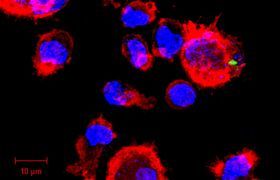Antibiotic resistance: ‘a faceless pandemic’
15 April 2021 | Story Niémah Davids. Photo Getty Images. Read time 7 min.
The rapid increase in antibiotic-resistant bacteria – in South Africa and across the globe – is driven by the misuse and overuse of antibiotics in humans and food-producing animals and poses a huge threat to modern medicine.
This is the view of the University of Cape Town’s (UCT) Professor Marc Mendelson, the head of the Division of Infectious Diseases and HIV Medicine at Groote Schuur Hospital. He has also recently been re-appointed the chairperson of the national Department of Health’s Ministerial Advisory Committee on Antimicrobial Resistance.
Antimicrobial resistance occurs when micro-organisms such as bacteria, viruses, fungi and parasites change in ways that render ineffective the medications (antimicrobials) used to treat and cure the infections they cause. In South Africa, this type of drug resistance impacts tuberculosis (TB), HIV, malaria, and fungal infections. According to Professor Mendelson, antibiotic-resistant bacteria threaten modern medicine as we know it.
Antibiotic resistance
Mendelson described antibiotics as “naturally occurring” chemicals produced by fungi and bacteria in soil and other environments, and designed to kill competing bacteria. But through evolution, some bacteria have the ability to resist and evade antibiotics.
“When this happens, bacteria have a survival advantage and may become the dominant species in that environment.”
“When this happens, bacteria have a survival advantage and may become the dominant species in that environment,” he said.
Humans and animals are both symbionts with bacteria, Mendelson said. In fact, numerically the human body is made up of more bacteria than there are human cells – the average person carries around approximately 2 kg of bacteria.
But scientists refer to them as “good” bacteria; they are necessary and play a vital role in the body’s functionality. [They] impact the functioning of the immune system, aid food digestion and prevent harmful bacteria from “gaining a foothold at the interface [of] the body”.
“When we take an antibiotic, bacteria that don’t possess resistance mechanisms will be killed off, while others that possess the ability to resist will survive. They may then become the dominant population, [and can] cause an antibiotic-resistant infection in our body [and] transfer [it] to others by touch, via droplets from our airways or during [unprotected] sex – depending on the type of bacteria – [and] cause infection in them,” Mendelson said.
“Catastrophic” increase
In the past few decades, Mendelson said, South Africa has seen a “catastrophic” increase in antibiotic consumption, the majority of which has been unnecessary. As a result, clinicians are now seeing common, everyday infections of the urinary tract, abdomen, lungs and brain that are resistant to first- and second-line antibiotics.
“In some cases we are left only with a last-resort antibiotic, colistin, that was removed from human use in the 1960s due to poor function and side effects.”
Mendelson said that clinicians are also witnessing more pan-drug-resistant infections (when pathogenic bacteria are resistant to antimicrobial agents) in patients. These infections require drastic measures to control them.
“Earlier this year, we had to amputate a woman’s leg to treat a pan-drug-resistant infection in her knee. [And] that wasn’t the first time this has happened,” he said.
Modern medicine – surgical operations, cancer care, HIV care, transplantation, and preventing and treating everyday infections – relies on functioning antibiotics. But as antibiotic resistance rates continue to increase, medicines “that we have taken for granted for decades are no longer working”.
Antibiotic consumption rates
South Africa’s high antibiotic consumption rates are also driven by food-production practices. Their processes make use of large quantities of antibiotics, Mendelson said, to promote growth in animals, avert illness and speed up the timeline for getting herds and flocks to the retail market.
This phenomenon has been around for decades and is done in order to maximise production and profits. However, he explained, antibiotics used for growth promotion are banned in the European Union and in many other countries. Governing organisations for animal health and food production have called for a cessation of all use of antibiotics for these purposes.
“Many of the gains from antibiotics used for animal growth promotion can be offset by improving infection-prevention (biosafety) measures on farms and with animal feed.”
“Many of the gains from antibiotics used for animal growth promotion can be offset by improving infection-prevention (biosafety) measures on farms and with animal feed,” he said.
“What happens in humans, happens in animals. Antibiotic use selects bacteria that are able to resist the action of that antibiotic. In this case, and what many people don’t know, is that antibiotic-resistant bacteria can be transferred from farm to fork during the food-production process.”
Furthermore, he explained, antibiotic residues from humans and animals enter the environment during antibiotic manufacture and through excretion of bodily fluids. They increase levels of antibiotic-resistant bacteria in the environment, which can enter the food chain and be passed from animal to human once again.
“Antibiotic resistance poses the quintessential ‘one health’ problem, and it’s driven by the abuse of antibiotics in humans and [food-producing] animals, as well as the contamination of the environment by antibiotics,” he said.
Mitigating the effects
According to global research, by 2050, 10 million people will die each year as a direct result of antibiotic-resistant infections – that’s four times more people than those who died from COVID-19 in the first year of the pandemic.
“Its threat has been framed largely as futuristic, rather than [like] the real-time threat of COVID-19, but it’s happening in the here and now. And the hammer blow is falling on Africa and Asia, where 88% of the estimated 10 million deaths will occur.”
Mendelson said that mitigating antibiotic resistance relies on five key pillars – infection prevention; good surveillance; optimisation of antibiotic use; research and development of new antibiotics, diagnostics and vaccines; and promoting education and awareness. Underpinned by these pillars, there is also a need for good governance and access to currently available antibiotics.
“Unlike COVID-19, antibiotic resistance remains a largely faceless pandemic. It’s not a single enemy that is as easily identifiable. But make no mistake, continued abuse of antibiotics is a direct threat to you, your family and [your] friends, and constitutes one of the world’s greatest public health crises.”
 This work is licensed under a Creative Commons Attribution-NoDerivatives 4.0 International License.
This work is licensed under a Creative Commons Attribution-NoDerivatives 4.0 International License.
Please view the republishing articles page for more information.










